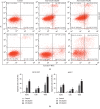Aloe-Emodin Induces Breast Tumor Cell Apoptosis through Upregulation of miR-15a/miR-16-1 That Suppresses BCL2
- PMID: 32190086
- PMCID: PMC7073502
- DOI: 10.1155/2020/5108298
Aloe-Emodin Induces Breast Tumor Cell Apoptosis through Upregulation of miR-15a/miR-16-1 That Suppresses BCL2
Abstract
Purpose: Aloe-emodin (AE) is a natural compound derived from aloe vera and palmatum rhubarb and shows anticancer activities in various cancers. Bcl-2 family is the main regulator of cell death or cell survival. This study describes the effects of AE on proliferation of breast tumor (BT) cells.
Methods: MCF-10A, MCF-10AT, MCF-7, and MDA-MB-231 cell lines were exposed to AE. Cell proliferation and apoptosis were assessed by CCK-8 and flow cytometry. Protein levels were measured by Western blotting. The levels of mRNA and miRNA were examined by RT-PCR. Bioinformatics was applied to screen miRNAs that bind to 3'-UTR of mRNA.
Results: The results showed that AE selective activity inhibited the proliferation and induced apoptosis of MCF-10AT and MCF-7 cells but exhibited no significant inhibition in MCF10A and MDA-MB-231 cells. Mechanistically, AE dose-dependently decreased the protein expression of Bcl-2 and Bcl-xl, while it increased Bax protein expression in MCF-10AT and MCF-7 cells. The levels of Bcl-xl and Bax mRNA were altered by AE treatment, which was consistent with the protein expression results. However, Bcl-2 mRNA levels were not affected in either cell line, suggesting that AE may modulate the protein translation of Bcl-2 through miRNAs. In all candidate miRNAs that bind to 3'-UTR of Bcl-2, miR-15a and miR-16-1 were dose-dependently downregulated by AE. Moreover, inhibition of miR-15a/16-1 could eliminate the inhibition of MCF-10AT and MCF-7 cells growth by AE and could reverse the downregulation of AE-induced Bcl-2 protein level.
Conclusion: Our research provides an important basis that AE induces BT cell apoptosis through upregulation of miR-15a/miR-16-1 that suppresses BCL2.
Copyright © 2020 Xuefeng Jiang et al.
Conflict of interest statement
The authors declare no conflicts of interest regarding the publication of this paper.
Figures






Similar articles
-
Aloe-emodin attenuates myocardial infarction and apoptosis via up-regulating miR-133 expression.Pharmacol Res. 2019 Aug;146:104315. doi: 10.1016/j.phrs.2019.104315. Epub 2019 Jun 14. Pharmacol Res. 2019. PMID: 31207343
-
Aloe-Emodin Enhances Tamoxifen Cytotoxicity by Suppressing Ras/ERK and PI3K/mTOR in Breast Cancer Cells.Am J Chin Med. 2017;45(2):337-350. doi: 10.1142/S0192415X17500215. Epub 2017 Feb 23. Am J Chin Med. 2017. PMID: 28231748
-
[Effect of miR-15a on induction of apoptosis in breast cancer MCF-7 cells].Zhonghua Zhong Liu Za Zhi. 2011 Nov;33(11):827-30. Zhonghua Zhong Liu Za Zhi. 2011. PMID: 22335947 Chinese.
-
Progressive resistance to apoptosis in a cell lineage model of human proliferative breast disease.J Natl Cancer Inst. 2001 May 16;93(10):776-82. doi: 10.1093/jnci/93.10.776. J Natl Cancer Inst. 2001. PMID: 11353788
-
MicroRNA-10a suppresses breast cancer progression via PI3K/Akt/mTOR pathway.Oncol Lett. 2017 Nov;14(5):5994-6000. doi: 10.3892/ol.2017.6930. Epub 2017 Sep 14. Oncol Lett. 2017. PMID: 29113237 Free PMC article.
Cited by
-
Phytoconstituents as emerging therapeutics for breast cancer: Mechanistic insights and clinical implications.Cancer Pathog Ther. 2025 Feb 28;3(5):364-382. doi: 10.1016/j.cpt.2025.02.006. eCollection 2025 Sep. Cancer Pathog Ther. 2025. PMID: 40923028 Free PMC article. Review.
-
Molecular mechanism of Rhubarb in the treatment of non-small cell lung cancer based on network pharmacology and molecular docking technology.Mol Divers. 2023 Jun;27(3):1437-1457. doi: 10.1007/s11030-022-10501-w. Epub 2022 Aug 6. Mol Divers. 2023. PMID: 35933455
-
miRNA-214-3p stimulates carcinogen-induced mammary epithelial cell apoptosis in mammary cancer-resistant species.Commun Biol. 2023 Oct 3;6(1):1006. doi: 10.1038/s42003-023-05370-4. Commun Biol. 2023. PMID: 37789172 Free PMC article.
-
Targeting drug resistance in breast cancer: the potential of miRNA and nanotechnology-driven delivery systems.Nanoscale Adv. 2024 Nov 12;6(24):6079-6095. doi: 10.1039/d4na00660g. eCollection 2024 Dec 3. Nanoscale Adv. 2024. PMID: 39569336 Free PMC article. Review.
-
Natural anti-cancer products: insights from herbal medicine.Chin Med. 2025 Jun 9;20(1):82. doi: 10.1186/s13020-025-01124-y. Chin Med. 2025. PMID: 40490812 Free PMC article. Review.
References
LinkOut - more resources
Full Text Sources
Research Materials
Miscellaneous

